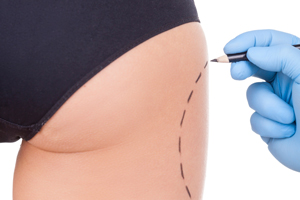Butt Implant surgery
Buttock Augmentation surgery is performed on patients who want a fuller and more proportionate buttocks. There are two main options for patients today, these include buttock implants and fat transfers, which are commonly known as the “Brazilian Butt Lift”. Most surgeons will recommend a fat transfer over implants because it is less risky, and looks and feels more natural. It is very common for patients undergoing gluteal augmentation to combine the surgery with a tummy tuck, or breast augmentation.
The ideal candidate
 A good candidate for gluteal augmentation includes a physically healthy patient who has realistic expectations from their surgeon and for the procedure. Patients who are unhappy with the appearance of their butt and feel it is too small, or asymmetrical may be good candidates for butt augmentations. Patients who are very thin will have to take into account that they will not be able to undergo fat transfer augmentation because they do not have enough fat for liposuction. Implants are typically a better option for thin patients but do pose more risk than fat transfer augmentation.
A good candidate for gluteal augmentation includes a physically healthy patient who has realistic expectations from their surgeon and for the procedure. Patients who are unhappy with the appearance of their butt and feel it is too small, or asymmetrical may be good candidates for butt augmentations. Patients who are very thin will have to take into account that they will not be able to undergo fat transfer augmentation because they do not have enough fat for liposuction. Implants are typically a better option for thin patients but do pose more risk than fat transfer augmentation.
Are butt implants real?
A fat transfer is when patients use their own fat to reshape their butt. This creates a lower risk of infection, and results in a more natural looking butt. Implants are not made of real body fat, and are typically recommended for patients who do not have a lot of fat and are unable to undergo a fat transfer.
How do butt implants work
Butt implants come in various shapes and sizes. Depending on the patient’s body type and goals for the procedure, the size of the implant will vary. The implants are silicone, which create a firm yet smooth appearance. When the implant is placed into the patient it will be placed away from certain nerves as well as away from the bone in which the patient sits on.
How long do butt implants last
After surgery patients will see an immediate difference in the appearance of their buttocks. Incision lines are permanent but will fade over time, and the final results of the buttock augmentation will become apparent after a few months when the shape and position settles in. Butt augmentation is long lasting and your butt size and shape will continue to change with gravity and age. If patients continue to be healthy and maintain their weight their butt augmentation will be long lasting.
Do butt implants feel real?
Most patients feel as though fat injections make their butts feel and look more real than implants. It all depends on the patient and the end result of the procedure.
What should be expected during surgery?
The patient’s buttock size and shape, amount of fat they have on their body, their goals and activity level, and their skin quality and elasticity will determine the type of procedure the patient will have.
In terms of anesthetics, medications are administered for the patient during the surgical procedures. This includes intravenous sedation and general anesthesia. Your doctor will recommend the best choice for the patient, but anesthesia will always be used to ensure the comfort of the patient throughout the procedure.
Buttock Implant Procedure
 Step 1 – An incision will be made, this can be toward the top of the upper buttock on each side of the patient, or toward the bottom in both of the gluteal creases, or between both cheeks (hidden in the crease) or with one incision placed down the center of the sacrum, or the crease between the buttocks. The length of the incision and scar is directly related to the affected areas. Depending on the patient and what the doctor recommends, the incisions will vary.
Step 1 – An incision will be made, this can be toward the top of the upper buttock on each side of the patient, or toward the bottom in both of the gluteal creases, or between both cheeks (hidden in the crease) or with one incision placed down the center of the sacrum, or the crease between the buttocks. The length of the incision and scar is directly related to the affected areas. Depending on the patient and what the doctor recommends, the incisions will vary.
Step 2 – Implant placement
A silicone implant especially chosen by the doctor and the patient is inserted either in the muscle or above the gluteal muscle on each side. The insertion and position of the implant depends on the type of implant, degree of enlargement desired, the patient’s body type, and the surgeon’s recommendations.
Step 3 – Closing the incisions
Next, the incisions are closed with layered stitches in the buttocks tissue. Skin adhesive or surgical tape is then used to close the skin.
Step 4 – Results
The results of buttocks augmentation are immediately visible after surgery. Over time, swelling will lessen and incision lines will fade. It’s important to note, the results of this surgery are permanent.
Fat Grafting/Brazilian Butt Lift Procedure
 Step 1 – Liposuction
Step 1 – Liposuction
Liposuction is performed through small, discreet incisions on areas of the patient’s body in which the doctor and patient agree upon. Diluted local anesthesia is given to the patient to reduce bleeding and trauma. Then a thin hollow tube is inserted through the incisions to loosen excess fat with a controlled back and forth motion. The freed fat is then suctioned out of the body.
Step 2 – Fat injection
The fat, tissue, and blood that were removed are then processed. The syringes are then connected to a special cannula, and your surgeon will use this cannula to add the fat to the buttocks through small injections all over the buttocks.
Step 3 – Results
The results of buttock augmentation are immediately visible after surgery but patients will not see their final results until almost a year after the surgery. On average patients will retain 60-80% of the transferred fat, but depending on the patient this will vary.
Risks
With any surgery there is possibility for negative side effects as well as results patients may not be happy with. Gluteal augmentation gone wrong may include some of the risks listed below:
Buttock Augmentation using an implant:
 Infection
Infection- Bleeding
- Opening of incisions
- Scarring
- Nerve damage
- Firmness
- Implant rupture
- Implant migration
- Seroma (fluid accumulation)
- Anesthesia risks
 Buttock augmentation by fat transfer risks:
Buttock augmentation by fat transfer risks:
- Excessive loss of blood
- Blood clots
- Bruising
- Possibility of revision surgery
- Numbness and pain
- Infection
- Liposuction complications
- Anesthesia complications
- Swelling and bruising
- Asymmetry
- Fatty tissue found deep in the skin might die (fat necrosis)
- Hematoma
- Cellulite
Recovery
After a gluteal augmentation patients cannot sit directly on their buttocks for three weeks. Typically patients are out of work for two weeks, and can resume all normal activity after four weeks. During recovery, compression garments should be worn to reduce the swelling, and patients will typically have some bruising, swelling, and discomfort after the procedure. There are also specific massage techniques your doctor will show you to ease the pain.




